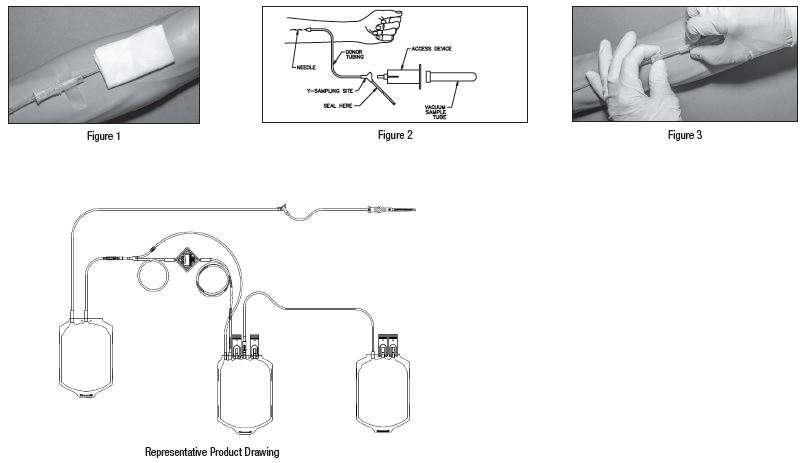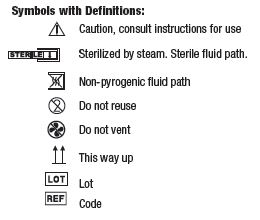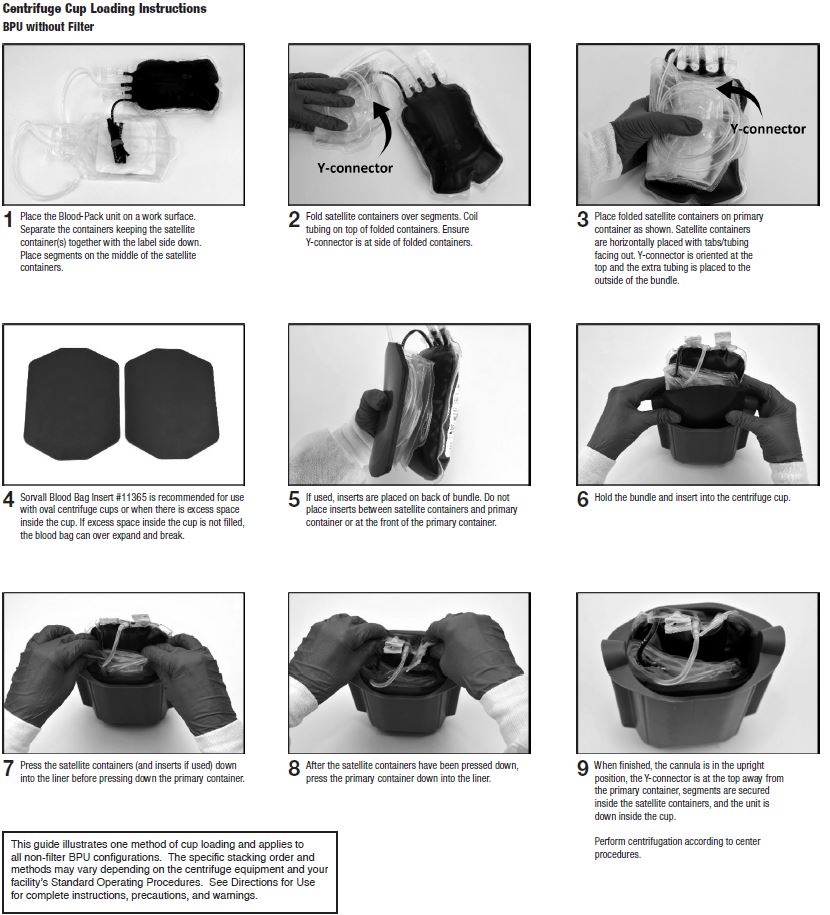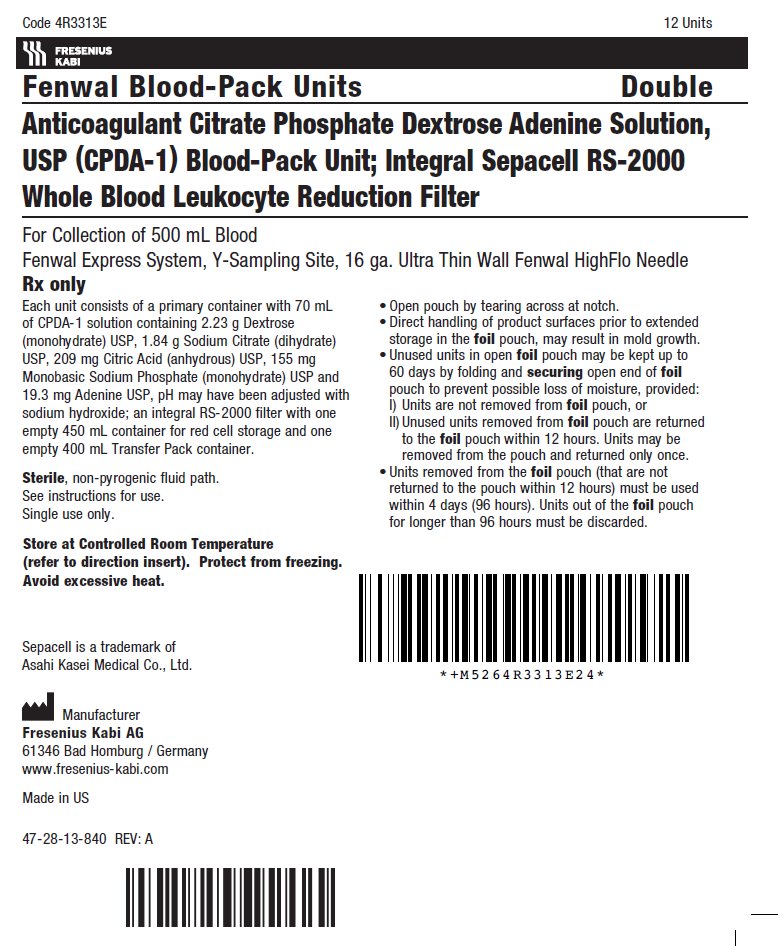4R3313E
Fresenius Kabi
Fenwal Blood-Pack Units Rx only
Using Anticoagulant Citrate Phosphate Dextrose Adenine Solution, USP (CPDA-1) with an Integral Sepacell RS-2000 Whole Blood Leukocyte Reduction Filter and Fenwal HighFlo Needle
Contains Fenwal Express System and Y-Sampling Site for the collection of unanticoagulated whole blood samples for laboratory testing.
Integral filter unit intended for leukocyte reduction of Whole Blood up to 8 hours after blood collection when Whole Blood is stored at ambient temperature or up to 72 hours after blood collection when Whole Blood is refrigerated. The leukocyte reduced blood products may then be stored for the maximum allowable dating period.
Instructions for Use
Collection Procedure:
Use aseptic technique.
- Notes:
- • Nominal tubing dimensions of product are 0.118" inner diameter x 0.025" wall thickness.
- • If the Y-Sampling Site is not used, donor samples may be collected using an alternate method following standard procedures.
Precautions:
- • Upon removal of Blood-Pack unit from the clear plastic overwrap, visually inspect the unit.
- • Do not use unless the solutions are clear.
- • Before beginning procedure, obtain one access device for each Blood-Pack unit with Y-Sampling Site to be processed.
1. Identify Blood-Pack unit using appropriate donor identification system.
- 2. Donor Scale
- • Adjust donor scale to desired collection weight.
- • Position primary container on the donor scale as far as possible below donor arm.
3. Clamp donor tubing between HighFlo1 needle and primary container. This step may be performed prior to step 1 or 2.
- 4. Apply pressure to donor’s arm and disinfect site of venipuncture.
- 5. Remove needle cover per instructions below:
- • Holding the hub and cover near the tamper-evident seal, twist cover and hub in opposite directions to break seal.
- • Remove needle cover, being careful not to drag the cover across the needle point.
- 6. Following blood center procedures, perform venipuncture, appropriately secure donor needle and/or tubing and release clamp on donor tubing.
- 7. When good blood flow is established, stabilize the front of the needle guard to arm with tape. (see Figure 1)
- 8. Mix blood and anticoagulant in primary container immediately, at several intervals during collection, and immediately after collection.
- 9. Collect the appropriate volume based on Blood-Pack unit used.
- Note: The volume of anticoagulant is sufficient for the blood collection indicated on Blood-Pack unit ± 10%.
- 10. Release the pressure on the donor’s arm as appropriate.
Precaution: Do not proceed with the remaining steps until the entire whole blood unit is collected.
11. To avoid possible contamination of the whole blood unit, before filling whole blood sample tubes, hermetically seal the donor tubing near the Y-Sampling Site on the side leading to the primary container using a metal clip or appropriate alternate method.
Precaution: Complete steps 12 - 21 within approximately 4 minutes after sealing the donor tubing to avoid possible clot formation in the tubing.
12. To collect samples, insert the access device by pushing firmly into the Y-Sampling Site until the membrane seal is penetrated (see Figure 2).
- Note: If the access device is assembled such that the outer barrel is screwed onto the Luer, make sure to rotate clockwise upon insertion to avoid barrel detaching from Luer.
13. Open the cap on the access device (if applicable).
14. Directly align the vacuum sample tube with the internal needle in the access device. Insert vacuum sample tube into device until the stopper is punctured.
15. Allow vacuum sample tube to fill with blood then remove from the access device.
16. Repeat steps 14 and 15 until the desired number of vacuum sample tubes have been filled.
- Notes:
- • If the access device needs to be replaced, clamp the tubing between the needle and the Y-Sampling Site. Then, grasp base of Sampling Site with one hand and pull the access device out with the other hand. Firmly insert the new access device as before. Remove clamp and continue sampling.
- • If the access device is assembled such that the outer barrel is screwed onto the Luer, make sure to rotate clockwise upon removal to avoid barrel detaching from Luer.
- • The access device can only be replaced one time.
Precaution: When replacing the access device, be careful to avoid contact with any blood droplets on the Luer or Sampling Site. Discard used access device appropriately.
17. Release remaining pressure on donor’s arm.
18. If appropriate, apply clamp to donor tubing between needle and Y-Sampling Site.
19. Withdrawal of Needle (see Figure 3)
Precaution: The needle guard must be held stationary while the needle is withdrawn into it.
- a) Place folded sterile gauze over puncture site and hold in place with finger tip without exerting pressure.
- b) Hold sides of needle guard near the front, between the index finger and thumb. Pull the hub back smoothly until the needle is completely enclosed and securely locked into the needle guard.
- c) Confirm the needle is completely enclosed and securely locked into the needle guard.
20. Remove and discard the Y-Sampling Site and needle in needle guard into an appropriate biohazardous waste container following established procedures. If donor tubing is also to be discarded, hermetically seal donor tubing directly above the primary container and remove.
Note: Step 21 may be performed prior to step 20 if desired.
21. If the donor tubing is not hermetically sealed directly above the primary container, then strip the blood from the remaining donor tubing into the primary container. Mix and allow tubing to refill; repeat once.
Filtration Procedure:
Precaution: Whole blood collected from certain donors may have extended filtration times and the potential for ineffective filtration and leukoreduction.
- Note: The time of Whole Blood filtration may vary depending on processing option selected.
- a) Within 8 hours of collection if Whole Blood is held at ambient temperature.
- b) Within 72 hours of collection if Whole Blood is refrigerated following collection.
22. Mix unfiltered Whole Blood thoroughly. Invert the primary container and hang the filter set such that the filter remains vertical. To achieve maximum flow rate, allow set to hang to full length.
Note: The filtered Whole Blood container must remain below the level of the filter during filtration. For proper air expression to occur, ensure the filtered Whole Blood container is vertical.
23. Inspect all tubing to insure it hangs freely without kinks. Install and close clamp on bypass line.
24. Break the in-line cannula above the filter to start filtration. To completely break the in-line cannula, grasp with both hands. Snap it at a 90° angle in one direction, and then bend it at a 90° angle in the opposite direction. Allow filtration to continue until flow stops.
Note: Manual or mechanical pressure should not be used to increase the flow rate through the filter.
- Note: Tubing below the filter should not be stripped at any time during the filtration process.
- Note: If the filtration of Whole Blood is initiated at ambient temperature and not completed within 8 hours after blood collection, then filtration should be completed between 1 and 6°C.
- Note: If recovery of residual blood in the primary container is desired, install and close a clamp on the segment line prior to removing the clamp on the bypass line. The segment line clamp can then be removed after step 25.
25. Open the clamp on the bypass line and allow air to transfer from the filtered Whole Blood container to the primary container.
Note: If desired, gently squeeze the filtered Whole Blood container to transfer remaining air through the bypass line.
26. Allow filtration to continue until the inlet side of the filter is filled with air.
27. Hermetically seal and separate the bypass line above the filtered Whole Blood container. Also hermetically seal and separate the segment line tubing directly above the top donor segment number. Use care to avoid fluid splatter. Discard filter and primary container appropriately.
Note: If a QC sample is desired, thoroughly mix the filtered Whole Blood and strip the donor segment tubing or bypass line tubing as desired. Use the tubing farthest away from the filtered Whole Blood container as the QC sample.
28. Make donor segments. Leave segments attached to the filtered Whole Blood container.
- Component Preparation Procedure:
- Note: Platelet concentrates are not intended to be made with this product.
29. At the appropriate time, prepare the Blood-Pack unit for centrifugation by thoroughly mixing the primary container end over end, then load the unit in a centrifuge cup per the instructions on page 3.
30. Following centrifugation, remove containers from the centrifugation cup taking care not to disturb the red blood cell / plasma interface.
31. Place filtered Whole Blood container in plasma extractor, and express plasma into empty Transfer-Pack container by releasing pressure plate and opening closure in tubing of filtered Whole Blood container.
32. When the desired amount of plasma has been removed, clamp the tubing between Y and plasma container. Hermetically seal and separate transfer tubing being careful to avoid fluid splatter.
33. Hermetically seal and separate transfer tubing near the container of filtered Red Blood Cells. Be careful to avoid fluid splatter.
34. For further processing of plasma product with multiple Blood-Pack units, use standard component processing and storage techniques.
Note: Fresh Frozen Plasma should be separated from the red blood cells and placed in the freezer at -18°C or colder within 8 hours after blood collection.
35. Store suspended CPDA-1 Whole Blood/Red Blood Cells, Leukocytes Reduced, (as applicable) between 1 and 6°C.
36. Infuse CPDA-1 Whole Blood/Red Blood Cells, Leukocytes Reduced, within 35 days of collection.
Warning: Failure to achieve closed system processing conditions negates the extended storage claim and the red blood cell product must be transfused within 24 hours.
Store at Controlled Room Temperature. Protect from freezing. Avoid excessive heat. Definition of “Controlled Room Temperature”: “A temperature maintained thermostatically that encompasses the usual and customary working environment of 20° to 25°C (68° to 77°F); that results in a mean kinetic temperature calculated to be not more than 25°C; and that allows for excursions between 15°C and 30°C (59° and 86°F) that are experienced in pharmacies, hospitals, and warehouses. Provided the mean kinetic temperature remains in the allowed range, transient spikes up to 40°C are permitted as long as they do not exceed 24 hours ...The mean kinetic temperature is a calculated value that may be used as an isothermal storage temperature that simulates the non isothermal effects of storage temperature variations.”
Reference: United States Pharmacopeia, General Notices. United States Pharmacopeial Convention, Inc. 12601 Twinbrook Parkway, Rockville, MD.
1 Van der Meer, P.F., & de Korte, D. “Increase of blood donation speed by optimizing the needle-to-tubing connection: an application of donation software.” Vox Sanguinis 2009, 97: 21-25
Sorvall is a trademark of Thermo Fisher Scientific LLC. Sepacell is a trademark of Asahi Kasei Medical Co., Ltd.
© 2019 Fresenius Kabi AG. All rights reserved
Manufacturer
Fresenius Kabi AG
61346 Bad Homburg / Germany
www.fresenius-kabi.com
1-800-933-6925
47-23-13-838 REV: A
PACKAGE/LABEL DISPLAY PANEL
Code 4R3313E 12 Units
Fresenius Kabi
Fenwal Blood-Pack Units Double
Anticoagulant Citrate Phosphate Dextrose Adenine Solution, USP (CPDA-1) Blood-Pack Unit; Integral Sepacell RS-2000 Whole Blood Leukocyte Reduction Filter
For the Collection of 500 mL Blood
Fenwal Express System, Y-Sampling Site, 16 ga. Ultra Thin Wall Fenwal HighFlo Needle
Rx only
Each unit consists of a primary container with 70 mL of CPDA-1 solution containing 2.23 g Dextrose (monohydrate) USP, 1.84 g Sodium Citrate (dihydrate) USP, 209 mg Citric Acid (anhydrous) USP, 155 mg Monobasic Sodium Phosphate (monohydrate) USP and 19.3 mg Adenine USP, pH may have been adjusted with sodium hydroxide; an integral RS-2000 filter with one empty 450 mL PL 146 Plastic container for red cell storage and one empty 400 mL Transfer Pack container.
Sterile, non-pyrogenic fluid path.
See instructions for use.
Single use only.
Store at Controlled Room Temperature (refer to direction insert).
- •
- Open pouch by tearing across at notch.
- •
- Direct handling of product surfaces prior to extended storage in the foil pouch, may result in mold growth.
- •
- Unused units in open foil pouch may be kept up to 60 days by folding and securing open end of foil pouch to prevent possible loss of moisture, provided:
- I.
- Units are not removed from foil pouch, or
- II.
- Unused units removed from foil pouch are returned to the foil pouch within 12 hours. Units may be removed from the pouch and returned only once.
- •
- Units removed from the foil pouch (that are not returned to the pouch within 12 hours) must be used within 4 days (96 hours). Units out of the foil pouch for longer than 96 hours must be discarded.
Sepacell is a trademark of Asahi Kasei Medical Co., Ltd.
Manufacturer
Fresenius Kabi AG
61346 Bad Homburg / Germany
www.fresenius-kabi.com
Made in USA
47-28-13-840 REV: A



